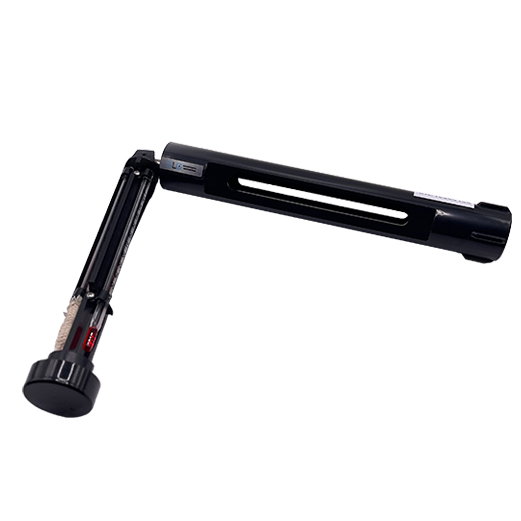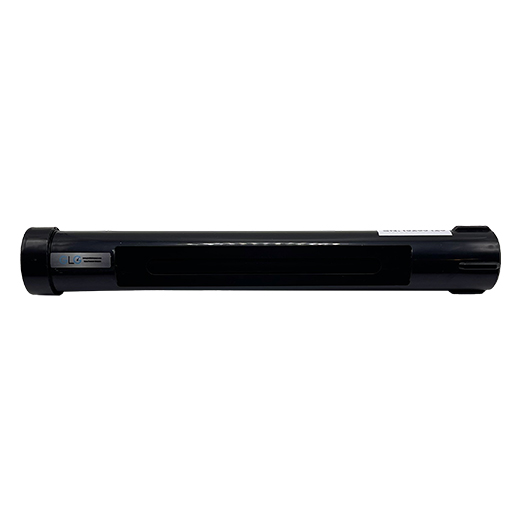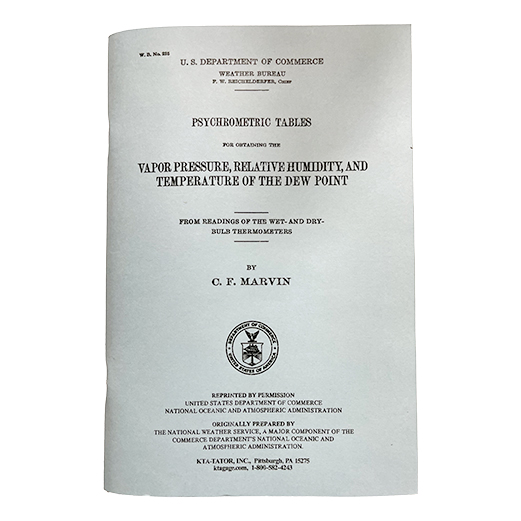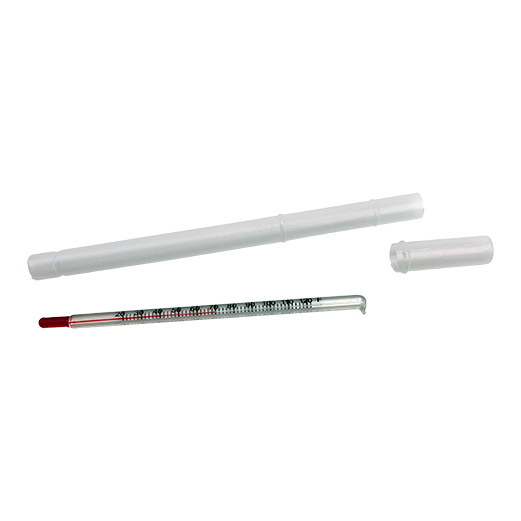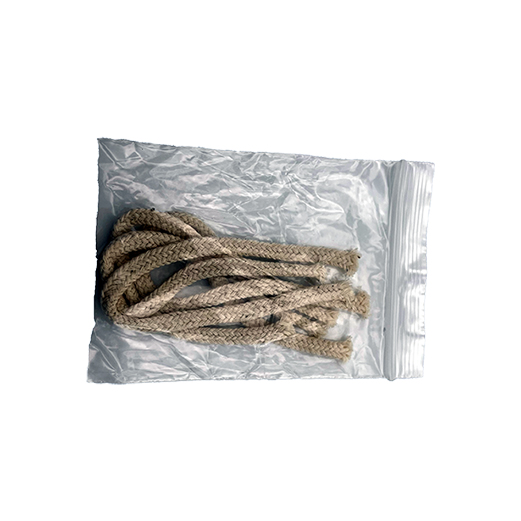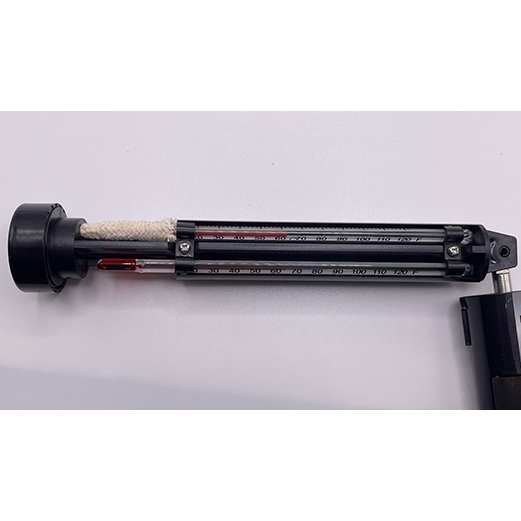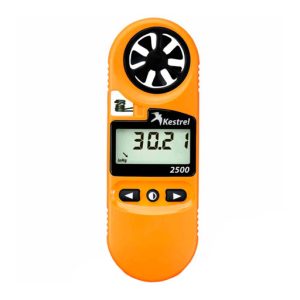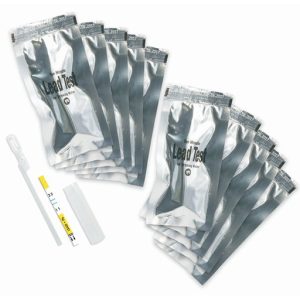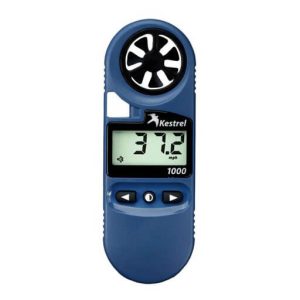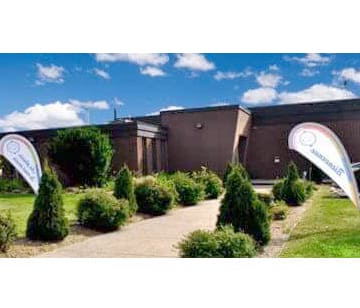Sling Psychrometer with NIST certificate
Bacharach type sling Psychrometer for indicating percent relative humidity on the basis of the wet bulb-dry bulb thermometer principle. The plastic case of the instrument is equipped with conversion scale for calculating the percent relative humidity.
Includes NIST Traceable Certification.
Using a Sling Psychrometer
Relative humidity can be measured by an instrument called a hygrometer. The simplest hygrometer – a sling psychrometer – consists of two thermometers mounted together with a handle attached on a chain. One thermometer is ordinary. The other has a cloth wick over its bulb and is called a wet-bulb thermometer.
When a reading is to be taken, the wick is first dipped in water and then the instrument is whirled around. During the whirling, the water evaporates from the wick, cooling the wet-bulb thermometer. Then the temperatures of both thermometers are read.
If the surrounding air is dry, more moisture evaporates from the wick, cooling the wet-bulb thermometer more so there is a greater difference between the temperatures of the two thermometers. If the surrounding air is holding as much moisture as possible – if the relative humidity is 100% – there is no difference between the two temperatures. Meteorologists have worked out charts of these differences for each degree of temperature so that the observer can find relative humidity easily.
Relative Humidity – Temperature in Celsius
The table below can be used to estimate the relative humidity of air if dry and wet bulb temperatures are known.
Dry Bulb Temperature = Tdb / Wet Bulb Temperature = Twb
Relative Humidity – RH (%)
Tdb – Twb
(oC)
| Relative Humidity – RH (%) | ||||||||
| Tdb – Twb (oC) |
Dry Bulb Temperature – Tdb (oC) | |||||||
| 15 | 18 | 20 | 22 | 25 | 27 | 30 | 33 | |
| 1 | 90 | 91 | 91 | 92 | 92 | 92 | 93 | 93 |
| 2 | 80 | 82 | 83 | 84 | 85 | 85 | 86 | 87 |
| 3 | 71 | 73 | 75 | 76 | 77 | 78 | 79 | 80 |
| 4 | 62 | 65 | 67 | 68 | 70 | 71 | 73 | 74 |
| 5 | 53 | 57 | 59 | 61 | 64 | 65 | 67 | 69 |
| 6 | 44 | 49 | 52 | 54 | 57 | 59 | 61 | 63 |
| 7 | 36 | 42 | 45 | 47 | 51 | 53 | 55 | 58 |
| 8 | 28 | 34 | 38 | 41 | 45 | 47 | 50 | 53 |
| 9 | 21 | 27 | 31 | 34 | 39 | 41 | 45 | 48 |
| 10 | 13 | 20 | 25 | 28 | 33 | 36 | 40 | 43 |
Relative Humidity – Temperature in Fahrenheit
| Relative Humidity – RH (%) | ||||||||
| Tdb – Twb (oF) |
Dry Bulb Temperature – Tdb (oF) | |||||||
| 60 | 64 | 68 | 72 | 76 | 80 | 84 | 88 | |
| 1 | 94 | 95 | 95 | 95 | 96 | 96 | 96 | 96 |
| 2 | 90 | 90 | 90 | 91 | 91 | 92 | 92 | 92 |
| 3 | 84 | 85 | 85 | 86 | 87 | 88 | 88 | 89 |
| 4 | 78 | 80 | 81 | 82 | 83 | 84 | 84 | 85 |
| 5 | 73 | 75 | 76 | 78 | 79 | 80 | 80 | 81 |
| 6 | 68 | 70 | 72 | 73 | 75 | 76 | 77 | 78 |
| 7 | 63 | 66 | 67 | 69 | 71 | 72 | 73 | 74 |
| 8 | 58 | 61 | 63 | 65 | 67 | 68 | 70 | 71 |
| 9 | 54 | 57 | 59 | 61 | 63 | 65 | 66 | 68 |
| 10 | 49 | 52 | 55 | 57 | 59 | 61 | 63 | 64 |
Sling Psychrometer with NIST certificate
Bacharach type sling Psychrometer for indicating percent relative humidity on the basis of the wet bulb-dry bulb thermometer principle. The plastic case of the instrument is equipped with conversion scale for calculating the percent relative humidity.
Includes NIST Traceable Certification.
Using a Sling Psychrometer
Relative humidity can be measured by an instrument called a hygrometer. The simplest hygrometer – a sling psychrometer – consists of two thermometers mounted together with a handle attached on a chain. One thermometer is ordinary. The other has a cloth wick over its bulb and is called a wet-bulb thermometer.
When a reading is to be taken, the wick is first dipped in water and then the instrument is whirled around. During the whirling, the water evaporates from the wick, cooling the wet-bulb thermometer. Then the temperatures of both thermometers are read.
If the surrounding air is dry, more moisture evaporates from the wick, cooling the wet-bulb thermometer more so there is a greater difference between the temperatures of the two thermometers. If the surrounding air is holding as much moisture as possible – if the relative humidity is 100% – there is no difference between the two temperatures. Meteorologists have worked out charts of these differences for each degree of temperature so that the observer can find relative humidity easily.
Relative Humidity – Temperature in Celsius
The table below can be used to estimate the relative humidity of air if dry and wet bulb temperatures are known.
Dry Bulb Temperature = Tdb / Wet Bulb Temperature = Twb
Relative Humidity – RH (%)
Tdb – Twb
(oC)
| Relative Humidity – RH (%) | ||||||||
| Tdb – Twb (oC) |
Dry Bulb Temperature – Tdb (oC) | |||||||
| 15 | 18 | 20 | 22 | 25 | 27 | 30 | 33 | |
| 1 | 90 | 91 | 91 | 92 | 92 | 92 | 93 | 93 |
| 2 | 80 | 82 | 83 | 84 | 85 | 85 | 86 | 87 |
| 3 | 71 | 73 | 75 | 76 | 77 | 78 | 79 | 80 |
| 4 | 62 | 65 | 67 | 68 | 70 | 71 | 73 | 74 |
| 5 | 53 | 57 | 59 | 61 | 64 | 65 | 67 | 69 |
| 6 | 44 | 49 | 52 | 54 | 57 | 59 | 61 | 63 |
| 7 | 36 | 42 | 45 | 47 | 51 | 53 | 55 | 58 |
| 8 | 28 | 34 | 38 | 41 | 45 | 47 | 50 | 53 |
| 9 | 21 | 27 | 31 | 34 | 39 | 41 | 45 | 48 |
| 10 | 13 | 20 | 25 | 28 | 33 | 36 | 40 | 43 |
Relative Humidity – Temperature in Fahrenheit
| Relative Humidity – RH (%) | ||||||||
| Tdb – Twb (oF) |
Dry Bulb Temperature – Tdb (oF) | |||||||
| 60 | 64 | 68 | 72 | 76 | 80 | 84 | 88 | |
| 1 | 94 | 95 | 95 | 95 | 96 | 96 | 96 | 96 |
| 2 | 90 | 90 | 90 | 91 | 91 | 92 | 92 | 92 |
| 3 | 84 | 85 | 85 | 86 | 87 | 88 | 88 | 89 |
| 4 | 78 | 80 | 81 | 82 | 83 | 84 | 84 | 85 |
| 5 | 73 | 75 | 76 | 78 | 79 | 80 | 80 | 81 |
| 6 | 68 | 70 | 72 | 73 | 75 | 76 | 77 | 78 |
| 7 | 63 | 66 | 67 | 69 | 71 | 72 | 73 | 74 |
| 8 | 58 | 61 | 63 | 65 | 67 | 68 | 70 | 71 |
| 9 | 54 | 57 | 59 | 61 | 63 | 65 | 66 | 68 |
| 10 | 49 | 52 | 55 | 57 | 59 | 61 | 63 | 64 |






